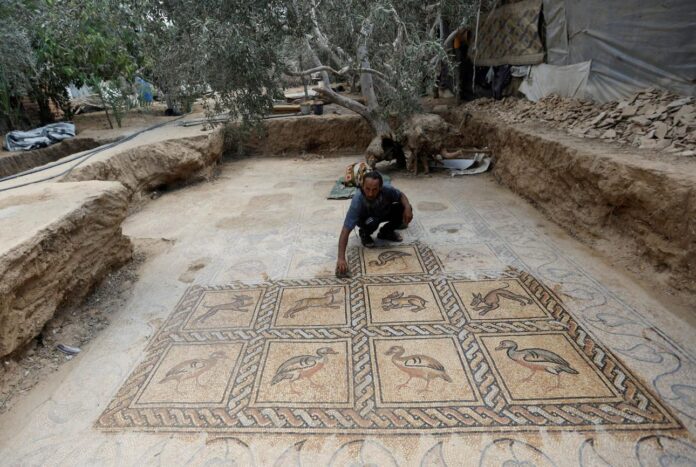The recent discovery of an important Byzantine mosaic in the Gaza Strip has raised concern from experts who fear for its preservation amid ongoing conflict in the area.
The ornate, brightly coloured relic features 17 iconographies of beasts and birds. It was found in the refugee camp of Bureij, just half a mile from the Israeli border, by the Palestinian farmer Salman al-Nabahin and his son as they were planting an olive tree on their land last spring. Parts of the mosaic had been damaged by the roots of old olive trees; they covered the unearthed pieces with tin sheets and reported it to local authorities.
But in the wake of recent Israeli Defence Forces (IDF) bombings in the area and an ongoing blockade, scarce resources are left for archaeological matters and the news has not been given proper attention. Hamas authorities have declined comment, meanwhile Gaza’s ministry of of antiquities has only mentioned “a big archaeological discovery,” deferring further comment for a formal announcement in a few days’ time.
After seeing videos and photos of the site, René Elter, an archaeologist from the French Biblical and Archaeological School of Jerusalem who has worked in Gaza but is currently unable to visit the site, told AP the mosaic floor was the most beautiful discovered in Gaza: “Never before have mosaic floors of this finesse, this precision in the graphics and richness of the colours been discovered in the Gaza Strip.”
The archaeologist Asa Eger—a specialist in Byzantine and Islamic archaeology in the Levant at the University of North Carolina at Greensboro —tells The Art Newspaper: “It is a spectacular find, especially as our knowledge of archaeology is sadly so spotty given circumstances there. Gaza was very important during the period of this mosaic and known for its burgeoning wine production exported across the Mediterranean.”
But Elter expressed concern that the discovery is in “immediate danger” because it is so close to the Israeli separation fence. “It is imperative to quickly organise an emergency rescue intervention,” he says.
Gaza’s longstanding status as a war zone under an Israeli-Egyptian blockade since 2007 has made it extremely difficult for foreign archaeology teams to work there. As a result, many important discoveries in the densely populated strip of land layered with the remnants of civilisations spanning five millennia happen rather accidentally.
A decade ago, workers digging around Salahedin Street in Gaza City unearthed a Byzantine Church that was later damaged by IDF bombing in November 2012, when the offices of the Hamas-run Ministry of Tourism and Antiquities were also flattened. Last year, the ruins of St Hilarion monastery (dated to around 400), one of Gaza’s best-preserved sites, were found when construction workers began digging to build a new road.

























